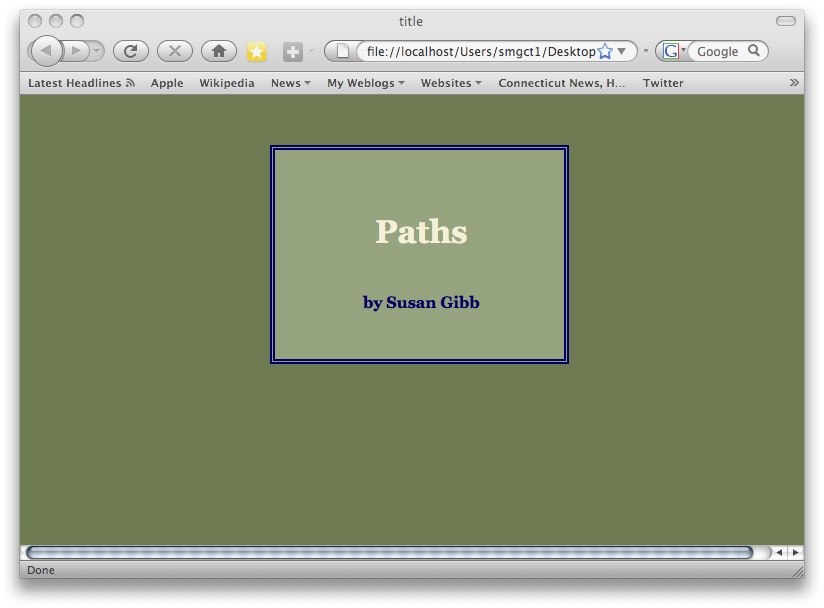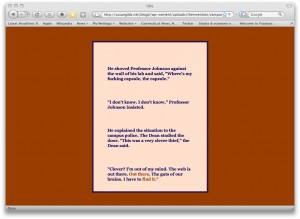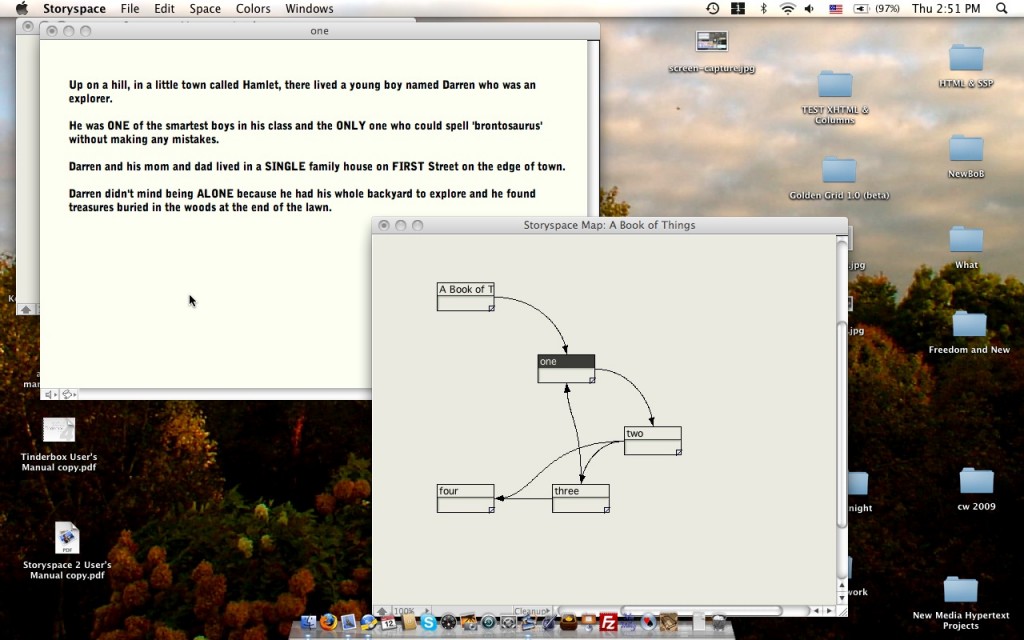Via Steve Ersinghaus’ post on Dene Grigar’s informative essay Electronic Literature: Where is it? on the selling of a new media field of study within university courses I find myself needing to voice my own un-academic points. As a student and proponent of the creative arena and its opportunity and promise, I may not have the knowledge of the underpinnings of a campus (though I would suspect the red tape of corporate doings doubled by formal overseer requirements such as state mandates), but I do have enough interest to offer a view from the outside looking in. Maybe I’ll start by following Ms. Grigar’s format in addressing the major points of the issue.
Reading patterns: With the new digital readers, i.e., Sony, Kindle, etc., the patterns of reading will be greatly changed and conclusions may not be drawn for a few years yet. My feeling has been that with the reading of news, communication via weblogs, social networking and emails, the door for e-lit is wide open, the opportunity for hypertext narrative the best it’s ever been because it is publishable and readable online. It is not a replacement for all book-reading but an alternative and handier than ever to upload in minutes rather than involving trips to bookstores and libraries. New generations, used to the information overload and seeming confusion and flash of a website are not as likely to be turned off by the medium.
Literary quality: I don’t think it’s just the idea of the visual effects and means that diminishes the work as of not “higher” literary quality, as much as the theory of close reading applies just as it does with traditional text. It would seem that a good portion of readers of new media indeed are those that are more interested in the ‘how’ of the piece rather than the narrative right now. This is exactly the same situation with traditional text in that the majority of readers are interested in conflict, adventure, pace rather than the underlying truth of a piece. The ‘how’ and intricacies that new media allows a piece may be a distraction to some, a joy to others, it being just another aspect of new media reading. Right now, no one really thinks about the font of a novel or the color of its page; yet there was a time when highly decorative illuminated pages were the norm and we’ve moved away from the visual.
Production and support of e-lit: e-lit should be a part of every English and literature course, just as software is being used for Statistics course, online research is displayed in history courses, programs are used in engineering courses, etc. The computer is a necessary part of nearly every class taught at any level in schools today. Does it need a separate curriculum? Is e-lit considered new media rather than literature? I would think that while expanded courses should be available, it should be included in the Intro to Lit course just as is Blake, Shakespeare, whomever, as an invitation as much as base knowledge.
To me, the whole new media scenario may need to be sold to the reading public simultaneously as it’s being corralled into a package for the curriculum. I made the comment that no classes had to be instituted to play Pac Man; the appeal of this totally new concept of gaming was thrown out to the public and met with enthusiasm that allowed it to swell into the highly sophisticated games and storyworlds that are available today. This response by the public has in fact created the desire to learn how to create this new medium and resulted in courses in design, animation, and digital storytelling. If the more literary end of new media wants to expand at the academic level, it needs to create a need. Creative growth of the medium will expand with the interest.
There probably should be more hypertext stories written and published (and made widely available) that are geared towards the elementary and high school level of reading. There is a very contemporary (though aging into classic) small library of hypertext available now and its appeal is mainly for the more creative and open-minded reader. Much of it is based on the good old marketing theory of ‘sex sells’. There is also the theory that hypertext must conform to the concept of alternate pathways and other structured ideas that seem to be as restrictive to the medium as any white paper page filled with inked text and bound to a bunch of others and packaged as a book. There is also the question of new material that might include some of the graphics’ appeal that the ‘classics’ just simply don’t offer. Just as Faulkner needs to be offered alongside Pychon, the original works in hypertext need to reflect the growth in the field on the production side. Few people who have played with Grand Theft Auto, Half Life, or the Sims will ever bother picking up Super Mario.
New Media literature also comes with a built-in obstacle to human nature even as it appeals to man’s curiosity and adventurous side; what I call the “getting in the wrong line at the supermarket” feeling. It is that unpleasant twinge that by making a choice, you’re making the wrong move. I personally love writing in the hypertext format and eagerly am trying to learn visual new media on my own, yet I must admit that I’m not all that nuts about either reading some of it for that reason, and often click out after a few ‘pages’ of floating, disappearing, and elusive text flashes by me. After centuries of being led through a narrative or poem, this concept of the reader creating the story is a hard sell to many who have become dependent upon the author to tell the story all by himself. I’ve done a quick survey of family and friends as to if they’ve ever pursued hypertext in their reading after college and unfortunately realized that most of them, having graduated in the early 90s, were not even exposed to it (and are getting anxiety attacks every time I force them to read it). But it would likely be a good idea for professors who have included new media literature in their curriculum to send out an email survey to those past students and simply ask them.
I suppose what I’m coming down to here is that while I have no voice as an academic to say what should or shouldn’t be available or how it should be presented in schools, I would as an advocate be a passionate supporter of this field of creativity and would more strongly support it as it shows promise of not being simply something passed through in lit class but available to the general public as an exciting and entertaining form of reading. The marketing to the public needs at least the same attention in order to create a basis for marketing to university structure.
(Added Note: Go ahead, get on amazon.com and see what’s available for hypertext reading, aside from ‘books’ on hypertext. A few of the oldies but goodies like Joyce and Falco, and they’re often listed as “out of print” (sic) and no longer available.)




 The Lost Children: A Charity Anthology
The Lost Children: A Charity Anthology